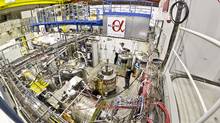We still don’t know why we exist, but thanks to a physics experiment named Alpha we’ve just come one step closer.
Alpha is located right next door to the Large Hadron Collider, Europe’s giant particle accelerator near Geneva, Switzerland. Canada is a key partner in the experiment which was built to measure the properties of antimatter – bizarre stuff that behaves like a mirror version of the matter that makes up our material world.
Antimatter is a scarce commodity in the universe – a good thing for us because this shortage has allowed galaxies, stars and life to emerge over the course of cosmic history. The trouble is physicists can’t explain why there isn’t more antimatter. Theory predicts that matter and antimatter should have been created in equal amounts when the universe began.
That’s where Alpha comes in. Using the experiment, researchers are searching for small disparities in the way matter and antimatter particles respond to the forces of nature. Even the slightest difference might account for how matter came to dominate.
“We can’t assume anything. We have to test everything,” Robert Thompson, head of the University of Calgary’s physics department and a long time member of the Alpha team, said.
In their latest result, published Wednesday in the journal Nature, Dr. Thompson and his colleagues report that antimatter hydrogen atoms – called antihydrogen – have no measurable electric charge and therefore behave just like ordinary hydrogen atoms do in an electric field.
Though not a surprise, the result marks a milestone and sets the stage for the next test, in which the researchers will attempt to measure the spectrum of antihydrogen – the wavelengths at which the antiatoms emit light. A few years later, a more challenging version of Alpha should allow them to determine if there is any difference in the way antimatter is affected by gravity.
The gravity phase of the experiment will be a Canadian-led effort. About $13-million in funding from the Canada Foundation for Innovation, together with the governments of Alberta, Ontario and British Columbia, have been allocated toward the project. But in order to detect any divergence in the way antimatter is affected by gravity, scientists must first rule out any unforeseen electrical effects.
It’s not an easy quest. As Star Trek fans well know, when matter and antimatter meet, they annihilate in a flash of pure energy. In science fiction, that makes for a handy way to power your starship. In the laboratory, it makes antimatter extremely difficult to work with.
To get around this, the Alpha team has mastered a technique for creating antihydrogen atoms and suspending them in a magnetic field long enough to make measurements.
The work demonstrates how far physics has come since British theorist Paul Dirac deduced the existence of antimatter in 1931 directly from the equations of quantum mechanics. The mathematics told Mr. Dirac that there should be a particle that is equal in mass to the electron but with an opposite electric charge. One year later the antielectron, also known as the positron, was observed in cosmic ray experiments. Physicists soon realized that every fundamental particle in nature comes with an antimatter reflection.
But these reflections conceal a hidden flaw.
Since the universe started out with matter and antimatter in balance, physicists must account for how matter came to dominate. The answer may open the door to a deeper theory that explains much more than just the antimatter conundrum.
One hypothesis that Alpha may be able to test is whether antimatter is pushed away rather than attracted by matter’s gravitational pull.
“If matter and antimatter repel each other, they would never collide, so the missing antimatter could be hiding in plain sight,” said Thomas Phillips, a physicist at the Illinois Institute of Technology, in an article accompanying the Alpha result.
In fact, any divergence from current theory that Alpha can detect would have a profound impact, said team member Scott Menary, a physicist at York University in Toronto. “We’d have to rethink everything.”
The study of antimatter may also yield practical benefits – though probably not in a starship, as it would take much more energy to produce antimatter fuel than the energy that fuel could deliver on an interstellar voyage. Instead, an experiment located near Alpha is studying the antimatter’s potential as a weapon against cancer cells.
Report Typo/Error




















